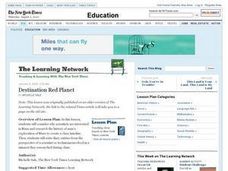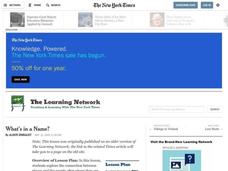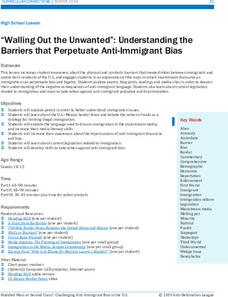Curated OER
Destination Red Planet
Students explore reasons why people are interested in exploring other planets. After reading an article, they identify developments in the mission to Mars. Using the internet, they research the history of exploring Mars and create a...
Curated OER
Literary Wizardry
Students discuss what they already know about the Harry Potter series. After reading an article, they examine a critic's reaction to the latest book in the series. As a class, they brainstorm what parts of their school day could use...
Curated OER
What's in a Name?
Students explore how one uses examples from history to inform themselves of past and present events. After reading an article, they examine the significance of renaming a base in Germany after a soldier who survived the Holocaust. They...
Curated OER
Grozny on Guard
Students react to copies of leaflets dropped into Chechnya by Russian forces. After reading an article, they examine the historical and present conflicts in the area and answer discussion questions. In small groups, they trace how the...
Curated OER
The 'Capital' of the World
Students are introduced to the purpose of the World Bank and its president Paul Wolfowitz. After reading an article, they work together to complete a writing exercise in which they use primary source documents to state their viewpoint. ...
Curated OER
Flights of Fancy?
Students reflect on the dynamics of human flight and how objects fall through the air and how science principles are used in flight.
They create a How-It-Works poster diagramming the science behind one method of flying. In addition,...
Curated OER
Modeling Atoms
High schoolers create an atomic model using a computer program. For this technology lesson, students identify the difference between radius and diameter. They create circular patterns and spheres based on certain specifications.
The New York Times
Where to Draw the Line: Balancing Government Surveillance with the Fourth Amendment
The question of how to balance Fourth Amendment Rights with national security concerns becomes critical in an age of planned terrorist attacks, election interference, and fake news. Get young social scientists involved in the debate with...
University of California
Impact of the California Missions on Native Americans
While the Spanish claimed to bring civilization to California indigenous peoples, in reality, they also brought violence and forced assimilation to European values. Primary sources, such as the reports of Catholic priests and Europeans...
Roy Rosenzweig Center for History and New Media
End of the Cold War
How significant was the Cold War during the 20th century? After reading and analyzing speeches by Ronald Reagan and Mikhail Gorbachev, learners consider the historical context of foreign policy decisions made during the Cold War by both...
The New York Times
The One-Question Interview
Generate interest in current events, the theme of a new unit, or a research project. Individuals select a question from the list generated by the class, conduct one-on-one interviews, analyze the responses, draw conclusions based on...
Roy Rosenzweig Center for History and New Media
Rosa Parks and the Montgomery Bus Boycott
Participants examine two documents related to Rosa Parks and the bus boycott, sources that challenge some of the commonly held preconceptions about Rosa Parks. They then respond to discussion questions to reinforce understanding and...
The New York Times
Writing to Explain: Creating How-To Scripts and Demonstrations
Excuse me, can you give me directions? Scholars examine and practice technical writing to increase their ability to write directions. They participate in discussion, watch videos, and complete an assignment to create their own directions.
Curated OER
Your Digital Footprint: Leaving a Mark
A digital footprint is the trail of personal information that comes from purchasing online, tagging friends in photos, blogging, and using social media. Kids discuss what information can be tracked, privacy, and what your digital...
Bethel School District
Observations and Inference
What's the difference between qualitative and quantitative observations? Learners make observations, inferences, and predictions about their environment with a set of questions and activities that are applicable to either language arts...
The New York Times
Super Brand
Children can recognize popular brands from an early age, but these images symbolize much more than what they advertise. Take a journey through the design of a logo with a lesson that focuses on the history and ubiquity of the Super Bowl...
Curated OER
Thinking Ahead to Next Year
End your school year in reflection. Ask your class to leave advice for those who follow in their footsteps, or write informative letters to the teachers who teach them next year. This is a great way to gather memories, improvements,...
Curated OER
Wali Dad (India)
Wali Dâd tries to give away his valuables, yet greater and still greater gifts keep coming back to him in return. This is the moral learners will come to understand as they read a fun fairy tale from India. They read the passage and then...
Media Smarts
The Citizen Reporter
Ripped from the headlines! Discuss topical social issues like racism, discrimination, and diversity while exploring the concept of citizen journalism. Begin with a professional-looking presentation on the history of citizen journalism....
Anti-Defamation League
“Walling Out the Unwanted”: Understanding the Barriers that Perpetuate Anti-Immigrant Bias
As part of a study of immigrant bias, high schoolers investigate the language used in blogs, readings, media reports, and current legislation whose language perpetuates xenophobia. They then consider ways they can get involved in...
Curated OER
Art Tape Amusement Parks
In need of a quick way to get rid of extra art tape? This simple idea describes how learners can use it to create mini amusement parks. They'll form the tape into roller coasters, cars, and people with a little imagination and creative...
Curated OER
Collaborative Writing
Collaborative writing projects can be a lot of fun for students. They use a Scholastic Story Starter and the class blog to write a creative story containing basic story elements. The web link to Scholastic is included but non of the...
Curated OER
Puzzle Trees
Elementary artists use a collage and multi-media technique to create textured trees. They study the fall trees, discussing texture and what bare trees look like. They then use a variety of materials to create a textural piece.
Curated OER
Dragonfly Sculptures
Art projects are great when they apply to other subjects. First study insects, their parts, and their habitats. Then have little ones create a dragonfly. They use clothes pins, raffia, pipe-cleaners, and paint to construct their...

























